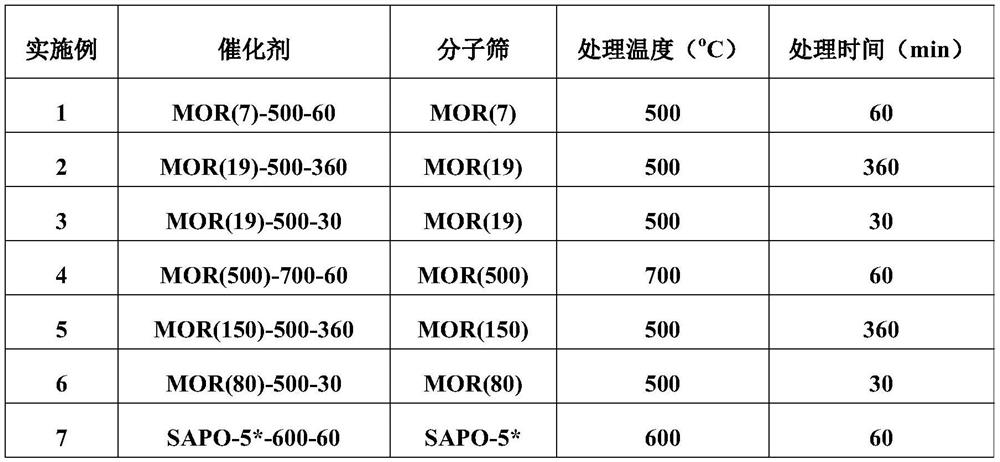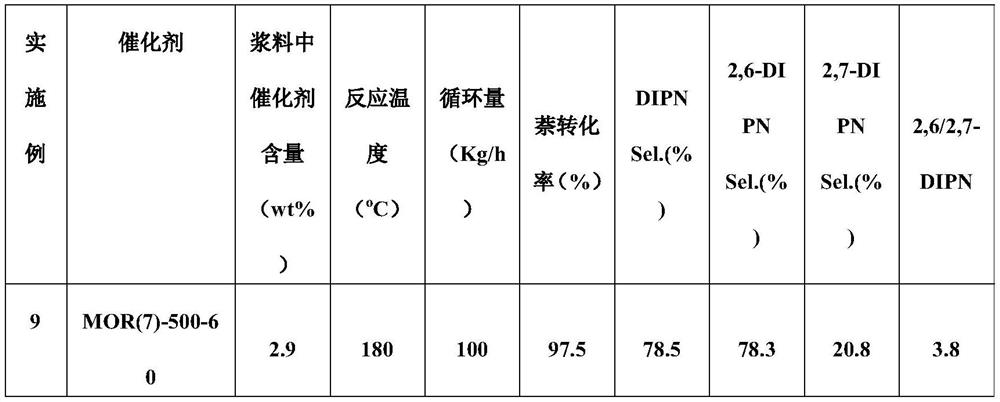Method for producing 2, 6-diisopropylnaphthalene
A technology of diisopropylnaphthalene and naphthalene source is applied in the field of producing 2,6-diisopropylnaphthalene, which can solve the problems of difficulty in continuous preparation, easy deactivation of catalysts, etc., and achieves high activity, low cost, and improved The effect of mass transfer efficiency
- Summary
- Abstract
- Description
- Claims
- Application Information
AI Technical Summary
Problems solved by technology
Method used
Image
Examples
Embodiment 1
[0044] Example 1 Catalyst preparation
[0045] Take 100 g of MOR molecular sieve (Si / Al=19) and place it in a tube furnace, heat it up to 500°C under nitrogen protection, stop feeding nitrogen, inject 25% ammonia water, and the feeding amount is 100 g / h. After treatment for 60 min, The ammonia water feed was switched to nitrogen purging for 30 min to cool down. The resulting catalyst was named MOR(19)-500-60.
Embodiment 2~8
[0046] Embodiment 2~8 catalyst preparation
[0047] The operation steps are the same as those in Example 1, and the molecular sieve types, treatment temperature and time are shown in Table 1.
[0048] Table 1 Preparation conditions table of catalysts
[0049]
[0050]
[0051] Note: Si / (Si+Al+P)=0.20 in SAPO-5
[0052] Example 9 Evaluation of the reaction performance of the catalyst using a loop reactor
[0053] 1.0 kg of catalyst MOR(7)-500-60 was loaded into a tube furnace, activated under nitrogen protection at 500° C. for 240 min, and then lowered to room temperature. Add 1.0kg of catalyst into the batching kettle, add 33.0Kg of industrial naphthalene, stir evenly, replace it with inert gas nitrogen three times, seal the batching kettle, and heat it to 100°C, which is called slurry.
[0054] A loop reactor with an effective volume of 10L was charged with 1.0kg of naphthalene, replaced with nitrogen, sealed, raised to 180°C, and pressurized to 1.0MPa with nitrogen,...
PUM
 Login to view more
Login to view more Abstract
Description
Claims
Application Information
 Login to view more
Login to view more - R&D Engineer
- R&D Manager
- IP Professional
- Industry Leading Data Capabilities
- Powerful AI technology
- Patent DNA Extraction
Browse by: Latest US Patents, China's latest patents, Technical Efficacy Thesaurus, Application Domain, Technology Topic.
© 2024 PatSnap. All rights reserved.Legal|Privacy policy|Modern Slavery Act Transparency Statement|Sitemap



